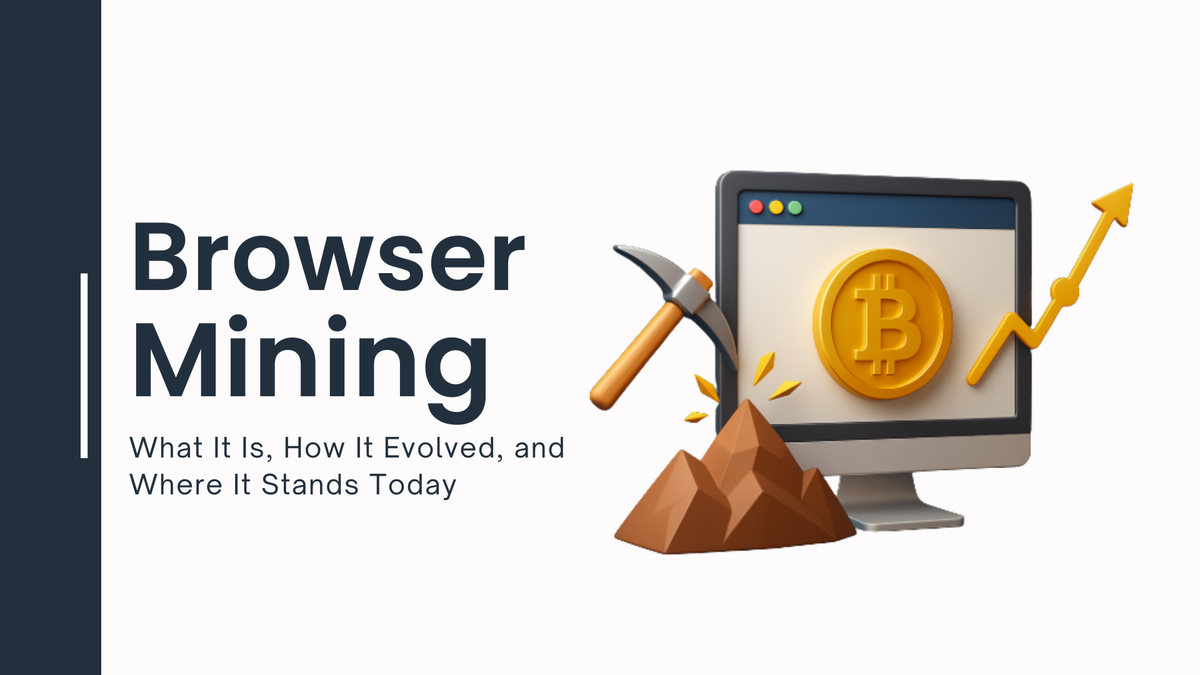Browser Mining: What It Is, How It Evolved, and Where It Stands Today

Introduction
Cryptocurrency mining is the process by which new digital coins are created and transactions are validated on blockchain networks. Traditionally, this requires powerful hardware and consumes significant amounts of electricity. But what if you could mine cryptocurrency simply by browsing the internet? This is the idea behind browser mining, a concept that once promised to democratize mining and offer a new way to monetize websites without ads.
What Is Browser Mining?
Browser mining refers to using scripts embedded in web pages to mine cryptocurrencies directly through your internet browser. This eliminates the need for expensive mining hardware like GPUs or ASICs. When you visit a site that has a mining script, your computer's CPU performs small calculations. called hashes, that contribute to solving cryptographic puzzles.
The earliest and most popular coin used for browser mining was Monero (XMR), chosen because its algorithm (originally CryptoNight, now RandomX) favors CPU mining over specialized mining rigs.
The idea was simple: instead of bombarding users with ads, websites could ask for permission to use visitors’ spare computing power to generate cryptocurrency. In theory, this created a “pay by computing” model where users paid for content or services with CPU cycles rather than cash.
How Does Browser Mining Work?
Browser mining typically involves JavaScript or WebAssembly (Wasm) code running on your device when you visit a site. Here's a step-by-step breakdown:
- Loading the Script: When you access the site, the mining script is downloaded alongside the webpage content.
- Connecting to the Mining Pool: Your browser connects to a mining pool, a group of users working together to mine cryptocurrency.
- Performing Computations: Your CPU is used to solve cryptographic puzzles. If a solution leads to a mined block, rewards are shared.
- Resource Usage: Mining is computationally intensive. It can consume up to 100% of your CPU, causing the device to overheat or slow down.
Many modern browsers detect and block unauthorized mining scripts, but some legitimate platforms still exist that request user consent before mining.
A Brief History of Browser Mining
Early Days: BitcoinPlus (2011)
The concept of browser mining started around 2011 with BitcoinPlus, which allowed users to mine Bitcoin through JavaScript. However, Bitcoin's mining difficulty soon outpaced the capabilities of browsers.
The Coinhive Boom (2017–2018)
Browser mining made a comeback in 2017 when Coinhive launched a JavaScript miner for Monero. Websites could embed Coinhive code and start earning crypto when users visit their pages.
Notable adopters included:
- The Pirate Bay: Tested mining as an alternative to ads.
- Salon.com: Allowed users to opt into mining instead of seeing advertisements.
- UNICEF: Used browser mining to raise funds for charitable causes.
The Rise of Cryptojacking
Unfortunately, cybercriminals saw an opportunity. They started embedding mining scripts into hacked websites without consent, hijacking users' devices, a practice known as cryptojacking.
According to security reports from Check Point and Palo Alto Networks, cryptojacking quickly became the most common form of web-based attack by 2018, outpacing even ransomware.
Collapse and Crackdown (2019)
By early 2019:
- Security firms blocked mining scripts as malware.
- Coinhive shut down in March 2019, citing low profitability.
- Other services like Crypto-Loot and JSEcoin also faded away.
Criticisms and Controversies
Security Risks
Mining without consent is essentially hacking. Users were unknowingly paying for someone else's gains through higher electricity bills and device wear.
Performance and Hardware Damage
Mining consumes processing power, which can:
- Slow down devices.
- Drain batteries.
- Overheat hardware.
- Shorten device lifespan.
Profitability Concerns
A major Vice report found that one of the largest Coinhive users running scripts on 11,000 websites earned just $7.69 over three months.
For individual users, profitability was and still is extremely low. The electricity cost often exceeds any crypto earned.
Environmental Impact
Even though browser mining uses less power per machine compared to industrial crypto mining, the aggregate global power consumption from millions of browsers could still result in significant energy waste.
Notable Platforms (Past and Present)
| Platform | Status | Coin Mined | Notes |
|---|---|---|---|
| BitcoinPlus | Inactive | Bitcoin | First browser miner (2011) but became obsolete. |
| Coinhive | Closed 2019 | Monero | Most famous; associated with cryptojacking. |
| JSEcoin | Closed 2020 | JSE | Tried ethical mining; failed due to low adoption. |
| CryptoTab Browser | Active | Bitcoin | Uses browser with built-in mining and referral bonuses. |
| Pi Network | Active | Pi Coin | Simulated mobile mining; millions of users . |
| Brave Browser | Active | BAT | Rewards users for viewing privacy-respecting ads. |
Current Landscape: Is Browser Mining Still Alive in 2025?
Browser mining is no longer mainstream, but some niche projects persist:
- CryptoTab Browser: Claims to mine Bitcoin while you browse. In reality, it's likely mining Monero or using cloud resources.
- Pi Network: A mobile app with millions of users "mining" Pi coins in a simulated environment without heavy computation.
- YouHodler Cloud Miner: Offers simulated mining as a gamified reward mechanism.
- Brave Browser: Pays users for ad attention instead of mining, representing a privacy-focused evolution of the model.
Profitability in 2025
- Even with tools like CryptoTab, users typically earn fractions of a cent per day without costly "boosts."
- Real mining is still dominated by specialized hardware and large-scale operations.
Conclusion
While the dream of earning passive crypto by browsing sounds attractive, the reality is that it's neither profitable nor environmentally friendly for most users. Today, there are better ways to earn crypto online, such as through staking, learning programs, or platforms like Brave.
For beginners, understanding the rise and fall of browser mining offers insight into the dynamic, experimental nature of the crypto space.
References
- Avast Blog – The End of Coinhive; The end of cryptojacking?
- Cointelegraph – Browser-based crypto mining in 2025: Still viable or virtually dead?
- Vice (Motherboard) – ‘One of the Biggest’ Coinhive Users Made $7.69 in 3 Months
- MDPI (Wu et al., 2022) – MinerGuard: A Solution to Detect Browser-Based Cryptocurrency Mining
- Palo Alto Networks Unit42 – Top Alexa Sites Infected With Malicious Coinminers
- Check Point Research – August 2019’s Most Wanted Malware
- Vice (Motherboard) – Mining Cryptocurrency to Pay for Journalism
- Brave Browser – Earn BAT by viewing privacy-respecting ads
MITOSIS official links:
GLOSSARY
Mitosis University
WEBSITE
X (Formerly Twitter)
DISCORD
DOCS



Comments ()